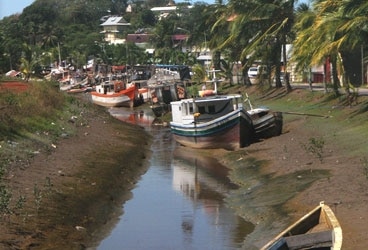
papilon 368
Just before actually stopping there, we’d never considered the notion of calling in French Guiana on our ongoing voyage Around the Americas (www.aroundtheamericas.org). In fact, all I knew about the tiny, enigmatic French Overseas Department in South America was that it was the setting for the harrowing prison movie called Papillon. (And speaking of mysteries, whose idea was it to cast Steve McQueen as a freaking Frenchman?) But on ocean voyages, of course, plans have a way of changing, and as we made our way south from Puerto Rico and then St. Lucia, bound for Cape Horn, we suddenly found ourselves digging out the charts for the capital city of Cayenne.
Actually, it’s not entirely accurate to say Cayenne was completely off our radar screen as a possible destination. Back in South Florida, we’d run into an old sailing pal, writer John Kretschmer, who’d pulled into the port on a previous voyage of his own. “It’s worth checking out, if you need to,” he said. “Cayenne is like a little corner of Paris.”
As it turned out, on the trip south toward the doldrums and the equator, bedeviled as we were by foul currents and relentless headwinds-and mindful of the necessity of getting to the Horn at the height of the southern summer-we’d spent many hours motorsailing with our 135-horsepower Lugger diesel, and by the time we closed the coast of French Guiana, we indeed needed to pull over for a fuel stop. Into Cayenne we went.
Well, that’s not entirely true. While a fleet of fishing boats does manage to make it in and out of a small canal on the tides, the main harbor in the city silted in many moons ago, so sailors calling in Cayenne actually head up an adjacent river called the Fleuve Mahury to a small marina about 15 kilometers out of town. As we sailed in, the river water became a deep brown; relatively speaking, the Amazon isn’t far down the coast, and its sediment-rich outflow muddies the waters many miles from its mouth.
The marina itself was a sea of French flags, and it’s an alluring destination for French sailors who use it to launch a Caribbean cruise or decide to stay awhile, find work, and kick back. Clearly, many of the boats in the marina had been there for some time and were going nowhere else soon.
There were no fuel docks; renting a car and ferrying jerry jugs back and forth from the gas station was a sweaty, all-day affair. And the price of diesel was a shocker, well over US$6 a gallon. But we didn’t have a ton of competing options.
When all that was done, we spent a day in Cayenne, a melting pot of cultures with a distinct Asian flavor: Many Chinese workers were the first immigrants, followed later by the Vietnamese, refugees from the French misadventure in their land. The market was busy, the architecture arresting, and the food terrific.
Plus, noted crewmate Dave Logan, “It has that whiff of colonial decay.”
We didn’t linger long in the place, for we had many miles ahead. But we left French Guiana a bit mystified. After all, we’d sailed to South America and found ourselves in France.








